Abstract
The ataxias are a complex group of diseases with both environmental and genetic causes. Among the autosomal dominant forms of ataxia the genes for two, spinocerebellar ataxia type 1 (SCA1) and Machado-Joseph disease (MJD), have been isolated. In both of these disorders the molecular basis of disease is the expansion of an unstable CAG trinucleotide repeat. To assess the frequency of the SCA1 and MJD trinucleotide repeat expansions among individuals diagnosed with ataxia we have collected DNA from individuals representing 311 families with adult-onset ataxia of unknown etiology and screened these samples for trinucleotide repeat expansions within the SCA1 and MJD genes. Within this group there are 149 families with dominantly inherited ataxia. Of these, 3% had SCA1 trinucleotide repeat expansions, whereas 21% were positive for the MJD trinucleotide expansion. Thus, together SCA1 and MJD represent 24% of the autosomal dominant ataxias in our group, and the frequency of MJD is substantially greater than that of SCA1. For the 57 patients with MJD trinucleotide repeat expansions, a strong inverse correlation between CAG repeat size and age at onset was observed (r = -.838). Among the MJD patients, the normal and affected ranges of CAG repeat size are 14-40 and 68-82 repeats, respectively. For SCA1 the normal and affected ranges are much closer, containing 19-38 and 40-81 CAG repeats, respectively.
Full text
PDF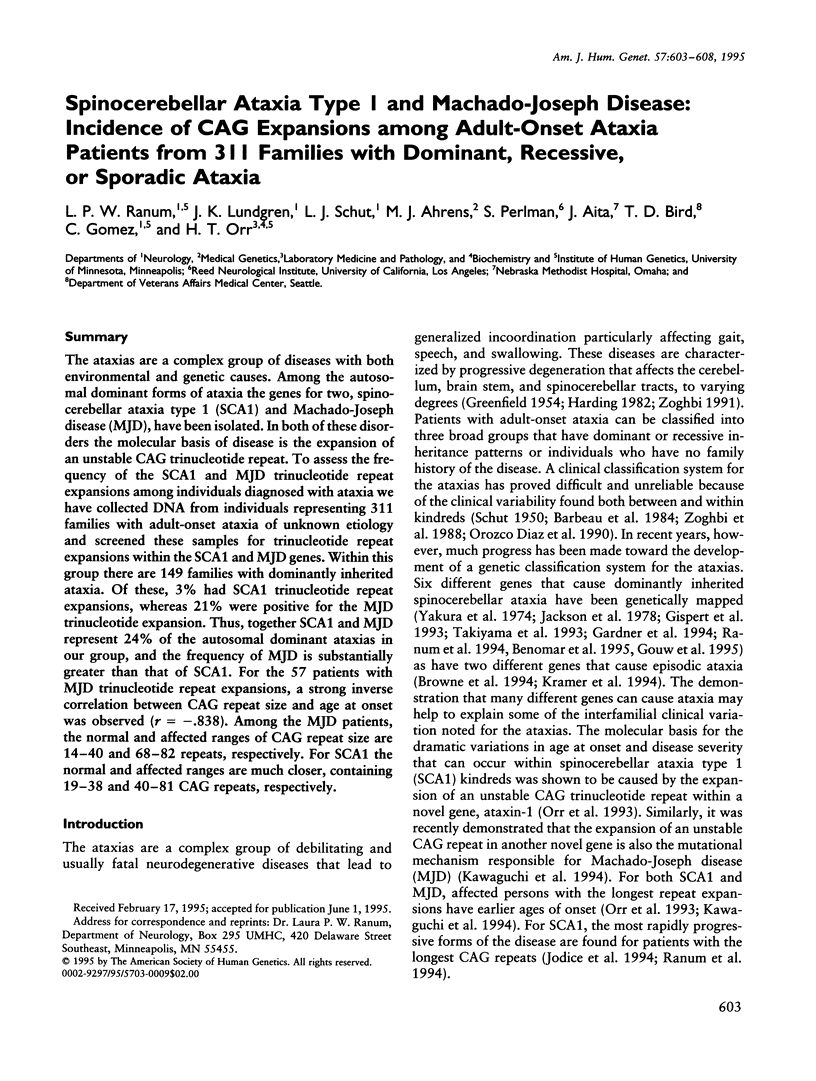
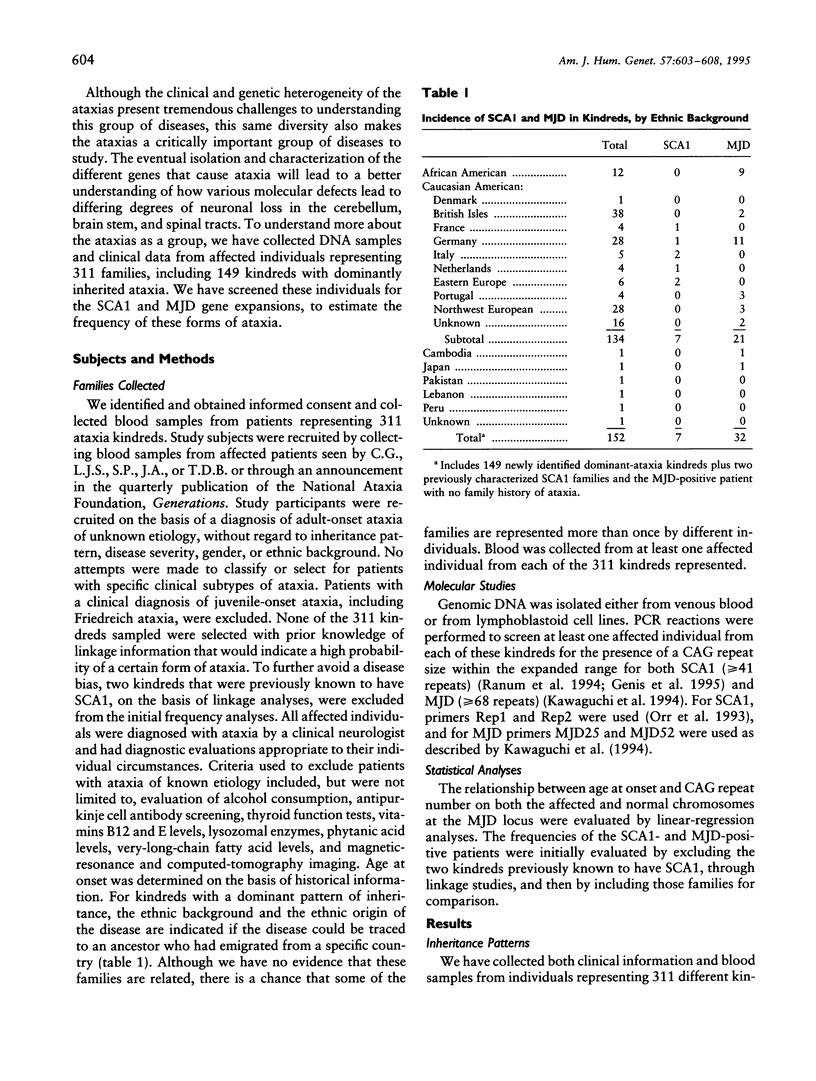
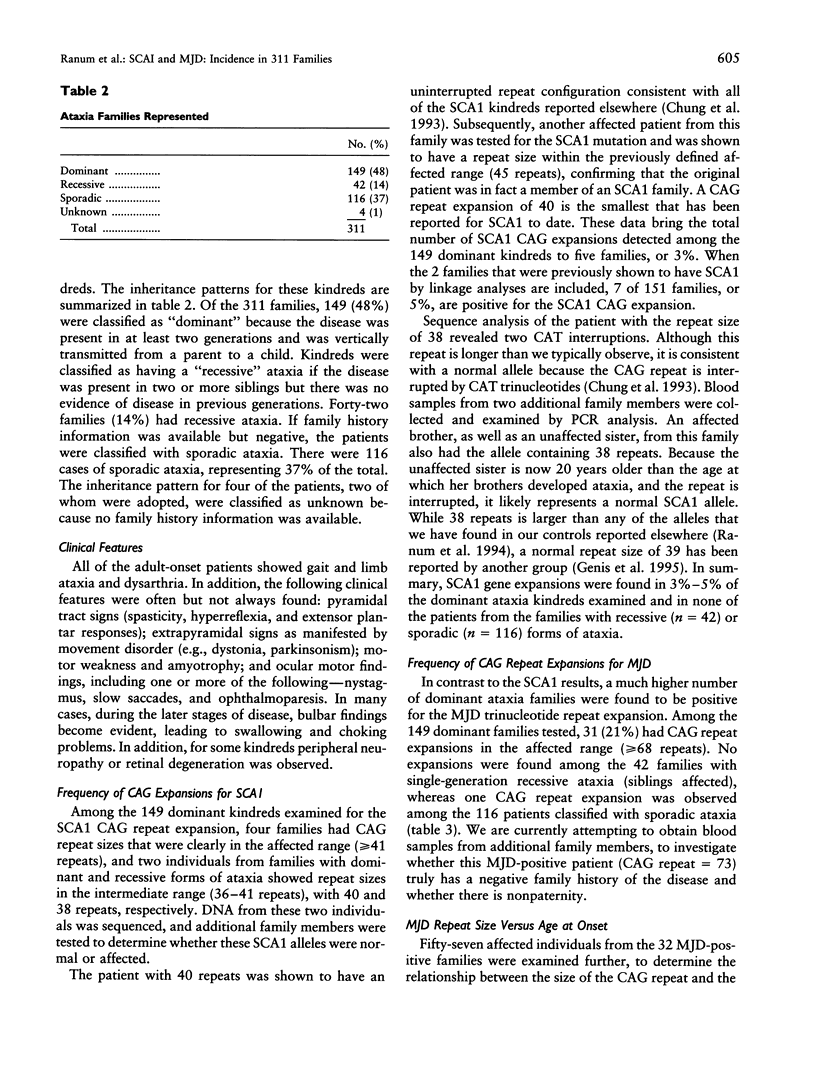
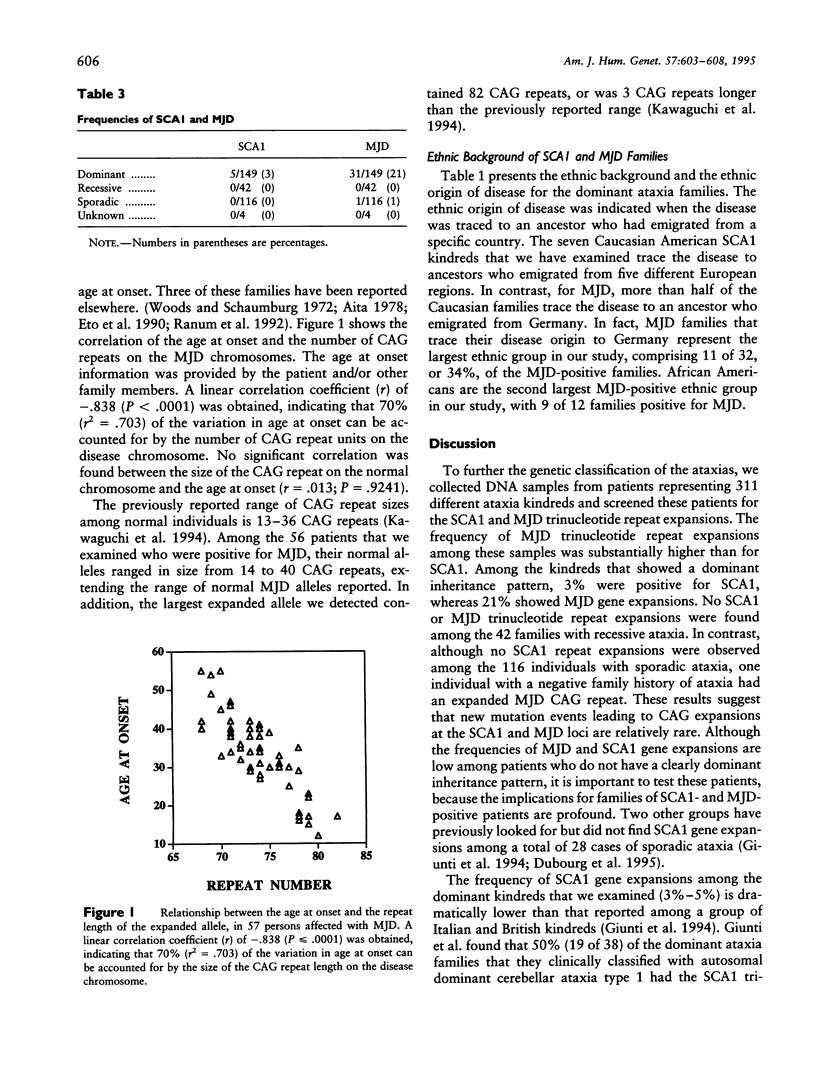
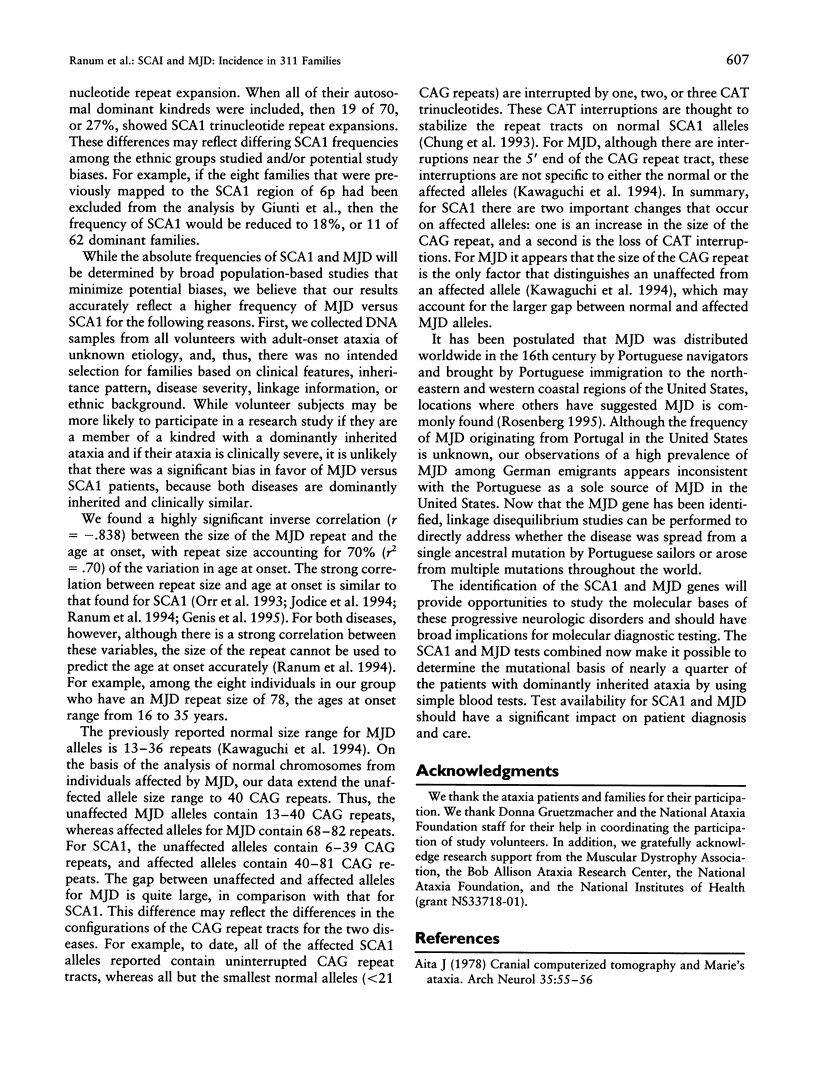
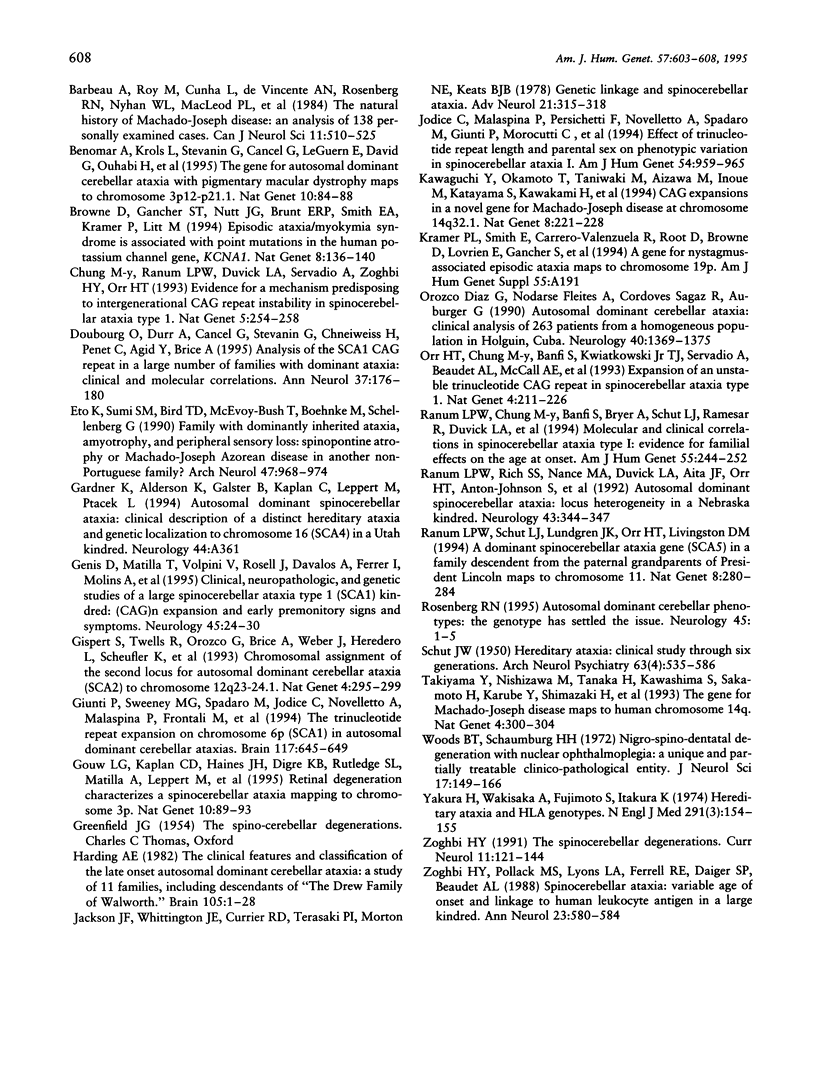
Selected References
These references are in PubMed. This may not be the complete list of references from this article.
- Aita J. F. Cranial computerized tomography and Marie's ataxia: a case report. Arch Neurol. 1978 Jan;35(1):55–56. doi: 10.1001/archneur.1978.00500250059016. [DOI] [PubMed] [Google Scholar]
- Barbeau A., Roy M., Cunha L., de Vincente A. N., Rosenberg R. N., Nyhan W. L., MacLeod P. L., Chazot G., Langston L. B., Dawson D. M. The natural history of Machado-Joseph disease. An analysis of 138 personally examined cases. Can J Neurol Sci. 1984 Nov;11(4 Suppl):510–525. doi: 10.1017/s0317167100034983. [DOI] [PubMed] [Google Scholar]
- Benomar A., Krols L., Stevanin G., Cancel G., LeGuern E., David G., Ouhabi H., Martin J. J., Dürr A., Zaim A. The gene for autosomal dominant cerebellar ataxia with pigmentary macular dystrophy maps to chromosome 3p12-p21.1. Nat Genet. 1995 May;10(1):84–88. doi: 10.1038/ng0595-84. [DOI] [PubMed] [Google Scholar]
- Browne D. L., Gancher S. T., Nutt J. G., Brunt E. R., Smith E. A., Kramer P., Litt M. Episodic ataxia/myokymia syndrome is associated with point mutations in the human potassium channel gene, KCNA1. Nat Genet. 1994 Oct;8(2):136–140. doi: 10.1038/ng1094-136. [DOI] [PubMed] [Google Scholar]
- Chung M. Y., Ranum L. P., Duvick L. A., Servadio A., Zoghbi H. Y., Orr H. T. Evidence for a mechanism predisposing to intergenerational CAG repeat instability in spinocerebellar ataxia type I. Nat Genet. 1993 Nov;5(3):254–258. doi: 10.1038/ng1193-254. [DOI] [PubMed] [Google Scholar]
- Dubourg O., Dürr A., Cancel G., Stevanin G., Chneiweiss H., Penet C., Agid Y., Brice A. Analysis of the SCA1 CAG repeat in a large number of families with dominant ataxia: clinical and molecular correlations. Ann Neurol. 1995 Feb;37(2):176–180. doi: 10.1002/ana.410370207. [DOI] [PubMed] [Google Scholar]
- Eto K., Sumi S. M., Bird T. D., McEvoy-Bush T., Boehnke M., Schellenberg G. Family with dominantly inherited ataxia, amyotrophy, and peripheral sensory loss. Spinopontine atrophy or Machado-Joseph Azorean disease in another non-Portuguese family? Arch Neurol. 1990 Sep;47(9):968–974. doi: 10.1001/archneur.1990.00530090038011. [DOI] [PubMed] [Google Scholar]
- Genis D., Matilla T., Volpini V., Rosell J., Dávalos A., Ferrer I., Molins A., Estivill X. Clinical, neuropathologic, and genetic studies of a large spinocerebellar ataxia type 1 (SCA1) kindred: (CAG)n expansion and early premonitory signs and symptoms. Neurology. 1995 Jan;45(1):24–30. doi: 10.1212/wnl.45.1.24. [DOI] [PubMed] [Google Scholar]
- Gispert S., Twells R., Orozco G., Brice A., Weber J., Heredero L., Scheufler K., Riley B., Allotey R., Nothers C. Chromosomal assignment of the second locus for autosomal dominant cerebellar ataxia (SCA2) to chromosome 12q23-24.1. Nat Genet. 1993 Jul;4(3):295–299. doi: 10.1038/ng0793-295. [DOI] [PubMed] [Google Scholar]
- Giunti P., Sweeney M. G., Spadaro M., Jodice C., Novelletto A., Malaspina P., Frontali M., Harding A. E. The trinucleotide repeat expansion on chromosome 6p (SCA1) in autosomal dominant cerebellar ataxias. Brain. 1994 Aug;117(Pt 4):645–649. doi: 10.1093/brain/117.4.645. [DOI] [PubMed] [Google Scholar]
- Gouw L. G., Kaplan C. D., Haines J. H., Digre K. B., Rutledge S. L., Matilla A., Leppert M., Zoghbi H. Y., Ptácek L. J. Retinal degeneration characterizes a spinocerebellar ataxia mapping to chromosome 3p. Nat Genet. 1995 May;10(1):89–93. doi: 10.1038/ng0595-89. [DOI] [PubMed] [Google Scholar]
- Harding A. E. The clinical features and classification of the late onset autosomal dominant cerebellar ataxias. A study of 11 families, including descendants of the 'the Drew family of Walworth'. Brain. 1982 Mar;105(Pt 1):1–28. doi: 10.1093/brain/105.1.1. [DOI] [PubMed] [Google Scholar]
- Jackson J. F., Whittington J. E., Currier R. D., Terasaki P. I., Morton N. E., Keats B. J. Genetic linkage and spinocerebellar ataxia. Adv Neurol. 1978;21:315–318. [PubMed] [Google Scholar]
- Jodice C., Malaspina P., Persichetti F., Novelletto A., Spadaro M., Giunti P., Morocutti C., Terrenato L., Harding A. E., Frontali M. Effect of trinucleotide repeat length and parental sex on phenotypic variation in spinocerebellar ataxia I. Am J Hum Genet. 1994 Jun;54(6):959–965. [PMC free article] [PubMed] [Google Scholar]
- Kawaguchi Y., Okamoto T., Taniwaki M., Aizawa M., Inoue M., Katayama S., Kawakami H., Nakamura S., Nishimura M., Akiguchi I. CAG expansions in a novel gene for Machado-Joseph disease at chromosome 14q32.1. Nat Genet. 1994 Nov;8(3):221–228. doi: 10.1038/ng1194-221. [DOI] [PubMed] [Google Scholar]
- Orozco Diaz G., Nodarse Fleites A., Cordovés Sagaz R., Auburger G. Autosomal dominant cerebellar ataxia: clinical analysis of 263 patients from a homogeneous population in Holguín, Cuba. Neurology. 1990 Sep;40(9):1369–1375. doi: 10.1212/wnl.40.9.1369. [DOI] [PubMed] [Google Scholar]
- Orr H. T., Chung M. Y., Banfi S., Kwiatkowski T. J., Jr, Servadio A., Beaudet A. L., McCall A. E., Duvick L. A., Ranum L. P., Zoghbi H. Y. Expansion of an unstable trinucleotide CAG repeat in spinocerebellar ataxia type 1. Nat Genet. 1993 Jul;4(3):221–226. doi: 10.1038/ng0793-221. [DOI] [PubMed] [Google Scholar]
- Ranum L. P., Chung M. Y., Banfi S., Bryer A., Schut L. J., Ramesar R., Duvick L. A., McCall A., Subramony S. H., Goldfarb L. Molecular and clinical correlations in spinocerebellar ataxia type I: evidence for familial effects on the age at onset. Am J Hum Genet. 1994 Aug;55(2):244–252. [PMC free article] [PubMed] [Google Scholar]
- Ranum L. P., Rich S. S., Nance M. A., Duvick L. A., Aita J. F., Orr H. T., Anton-Johnson S., Schut L. J. Autosomal dominant spinocerebellar ataxia: locus heterogeneity in a Nebraska kindred. Neurology. 1992 Feb;42(2):344–347. doi: 10.1212/wnl.42.2.344. [DOI] [PubMed] [Google Scholar]
- Ranum L. P., Schut L. J., Lundgren J. K., Orr H. T., Livingston D. M. Spinocerebellar ataxia type 5 in a family descended from the grandparents of President Lincoln maps to chromosome 11. Nat Genet. 1994 Nov;8(3):280–284. doi: 10.1038/ng1194-280. [DOI] [PubMed] [Google Scholar]
- Rosenberg R. N. Autosomal dominant cerebellar phenotypes: the genotype has settled the issue. Neurology. 1995 Jan;45(1):1–5. doi: 10.1212/wnl.45.1.1. [DOI] [PubMed] [Google Scholar]
- Takiyama Y., Nishizawa M., Tanaka H., Kawashima S., Sakamoto H., Karube Y., Shimazaki H., Soutome M., Endo K., Ohta S. The gene for Machado-Joseph disease maps to human chromosome 14q. Nat Genet. 1993 Jul;4(3):300–304. doi: 10.1038/ng0793-300. [DOI] [PubMed] [Google Scholar]
- Woods B. T., Schaumburg H. H. Nigro-spino-dentatal degeneration with nuclear ophthalmoplegia. A unique and partially treatable clinico-pathological entity. J Neurol Sci. 1972 Oct;17(2):149–166. doi: 10.1016/0022-510x(72)90137-2. [DOI] [PubMed] [Google Scholar]
- Yakura H., Wakisaka A., Fujimoto S., Itakura K. Letter: Hereditary ataxia and HL-A. N Engl J Med. 1974 Jul 18;291(3):154–155. doi: 10.1056/NEJM197407182910314. [DOI] [PubMed] [Google Scholar]
- Zoghbi H. Y., Pollack M. S., Lyons L. A., Ferrell R. E., Daiger S. P., Beaudet A. L. Spinocerebellar ataxia: variable age of onset and linkage to human leukocyte antigen in a large kindred. Ann Neurol. 1988 Jun;23(6):580–584. doi: 10.1002/ana.410230609. [DOI] [PubMed] [Google Scholar]


